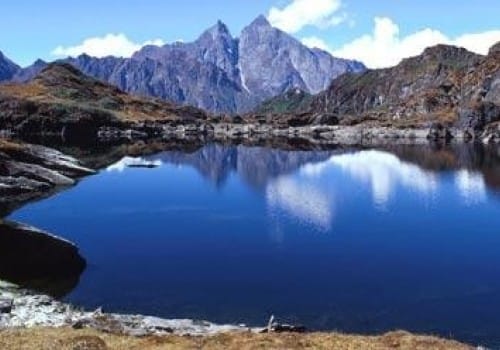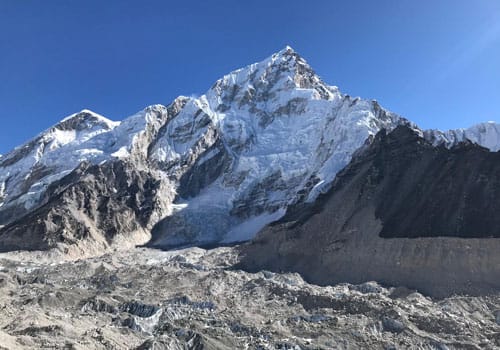The best months for trekking in the Himalayas largely depend on the specific region and the altitude of the trek. However, generally, the following periods are considered ideal for trekking:
Spring (March to May)
- Weather: Mild temperatures and blooming rhododendrons create beautiful landscapes
- Best For: Popular trek like the Everest Base Camp and Annapurna Circuit. The season is great for experiencing lush greenery and vibrant flora.
Autumn (September to November)
- Weather: Clear skies, stable weather, and cooler temperatures. The monsoon has usually ended, making trails less muddy.
- Best For: Trek such as the Annapurna Circuit and Langtang Valley. This period offers stunning views of the mountains and is considered the peak trekking season.
Winter (December to February)
- Weather: Cold temperatures, especially at higher altitudes, with the possibility of heavy snowfall
- Best For: Lower-altitude trek like……………….. Winter trek can be adventurous and less crowded but require proper gear and preparation.
Monsoon (June to August)
- Weather: Heavy rainfall and potential landslides, making trekking challenging and hazardous.
Best For: Generally not recommended for trekking in most regions due to the risk of landslides and slippery trails.
Summary
- Best Months: March to May (Spring) and September to November (Autumn) are the most popular and recommended times for trekking in the Himalayas due to favourable weather conditions and breathtaking views.
It’s essential to check the specific conditions and requirements for your chosen trek, as weather can vary significantly by region and altitude.
Altitude Effects
(1) Reduced Oxygen Levels:
- As altitude increases, the amount of oxygen in the air decreases. This can lead to symptoms of Acute Mountain Sickness (AMS), which include headaches, nausea, fatigue, and dizziness.
- Trekkers may experience decreased physical performance due to less available oxygen for muscle function.
(2) Acclimatization
- The body needs time to adapt to higher altitudes. Proper acclimatization involves as ascending gradually to allow the body to produce more red blood cells and improve oxygen transport.
- Failure to acclimatize can lead to serious altitude-related illness.
(3) Physical Fatigue
- Trekkers may feel more fatigued at high altitudes, as their bodies work harder to perform the same physical activities they could easily manage at lower elevations.
- Activities that require endurance, such as long climbs or steep ascents, can become significantly more challenging.
Weather Effects
- Temperature Variations
- Cold temperatures can lead to reduced dexterity and increased fatigue, making trekking more strenuous.
- Hypothermia and frostbite are risks in extreme cold, necessitating proper clothing and gear.
- Precipitation
- Rain or snow can make trails slippery and increase the risk of falls, which can affect trekking speed and safety.
- Wet conditions can lead to muddy trails, making it physically harder to navigate.
- Humidity and Heat
- High humidity and heat can lead to dehydration and heat exhaustion, affecting physical performance.
- Trekkers need to adjust their pace and take more frequent breaks to mange hydration and energy levels.
- Wind
- High winds can make trekking uncomfortable and increase the wind chill factor, leading to a higher risk of cold-related issues.
- Strong winds can also affect balance and stability on exposed trails.
Summary
- Physical Performance: Both altitude and weather can significantly hinder a trekker’s physical performance, leading to fatigue, discomfort, and increased risk.
Preparation: Understanding these factors is crucial for trekkers to prepare adequately, acclimatize properly, and choose appropriate gear to ensure safety and enjoyment during their trekking adventures.
Yes, most trekking routes require permits. The two main types are the TIMS (Trekkers’ Information Management System) card and specific area permits for regions like Annapurna, Langtang and Everest. Permits are included in the package.
Trekking in the Himalayas can range from easy to challenging. A moderate level of fitness is usually required, especially for higher altitudes. It’s advisable to prepare physically with regular hiking or walking.
Essential gear includes proper trekking boots, warm clothing, a good sleeping bag, a backpack, trekking poles, and a first-aid kit. It’s also important to have a good quality rain jacker, gloves and layers for warmth.
Yes, hiring a guide or porter is highly recommended, especially for those unfamiliar with the terrain. They can enhance your experience by providing local knowledge and assistance with carrying equipment.
Accommodation varies from teahouses and lodges to camping. In popular trekking areas, teahouses provide basic amenities, while camping offers a more immersive experience in nature.
Trekkers can find a variety of food options, including local Nepali dishes (like dal bhat), international cuisine, and snacks. Most teahouses offer menus with a range of choices.
While trekking is generally safe, it’s important to be cautious and aware of your surroundings. Following safety guidelines, staying with your group, and informing someone of your itinerary can help mitigate risks.
Most trek stat from major cities like Kathmandu or Pokhara. You can reach these cities by air or road, and from there, local transport options such as buses or private vehicles are available to trekking starting points.
Yes, travel insurance is strongly recommended. It should cover trekking at high altitudes, medical emergencies, and trip cancellations. Make sure to review the policy details before purchasing.



